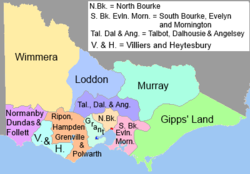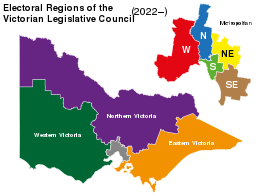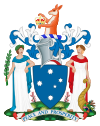Victorian Legislative Council
Legislative Council | |
|---|---|
Labor (15)
Victoria, Australia | |
| Website | |
| Vic Legislative Council |
The Victorian Legislative Council (VLC) is the upper house of the
The presiding officer of the chamber is the
The Chamber of the Legislative Council is noticably red - all carpet and furnishings in the chamber are red, which is a symbol of royalty and nobility. This aesthetic is in line with the United Kingdom's House of Lords. [2]
History
First Legislative Council

The separate colony of Victoria was proclaimed on 1 July 1851 and writs for the election of the first Legislative Council were issued at the same time for the 20 elected members.
The Legislative Council was expanded in 1853 to 18 nominees and 36 elected members.[9] A further expansion of the Council occurred in 1855, when 8 new members were elected from five new electorates, with one new nominee.[10] [11]
The first Legislative Council existed for five years and was responsible for at least three significant and enduring contributions to the parliamentary system of Victoria:
- it drafted the Constitution of Victoria, which provides the framework for the system of government in Victoria;
- it introduced the secret ballot. The Victorian Electoral Act 1856 introduced secret ballots on 19 March 1856,[12] an innovation at the time but now common around the world; and
- it ordered the construction of the Victorian Parliament House in Melbourne.
The new constitution was approved by the Legislative Council in March 1854 and was sent to Britain where it was passed by the United Kingdom Parliament as the Victoria Constitution Act 1855, received
Second Legislative Council

The new Constitution came into effect in 1856. It created a bicameral Parliament of Victoria, with the Legislative Assembly being the lower house and the Council being the upper house. The Council consisted of 30 members, with five members being elected from each of the six provinces.[16] The Parliament of Victoria first met on 21 November 1856 at the almost completed main sections of Parliament House. James Frederick Palmer was elected first President of the Council.
The Legislative Council was later elected from a varying number of provinces. In 1882, several new provinces were created while Central and Eastern were abolished.[17] In 1904, more provinces were created[18] and two members (MLCs) represented each province. The terms for members were two Assembly terms, and one member was elected in rotation at each election, by majority-preferential (AV) vote. Until 1950, the Legislative Council was elected on a restricted property-based franchise and always had a conservative majority.
Until 1958, elections for the Legislative Council were not held in conjunction with those for the Legislative Assembly, but starting at the
2003 reforms


The electoral system used to elect members of the Legislative Council changed for the 2006 Victorian election, as a result of major reforms passed by the Labor government, led by Steve Bracks, in 2003.[22] Under the new system the State is divided into eight electoral regions, each of which returns five members. These Legislative Council members serve terms linked to the Legislative Assembly, which has fixed four-year terms unless earlier dissolved in exceptional circumstances.
Each electoral region covers 11 contiguous Legislative Assembly electoral districts and has 420,000 electors.
Five regions are metropolitan (Melbourne and environs) (
Since 2006, Legislative Council members have been elected using the single transferable vote system of proportional representation. Each region elects five members. The quota for a seat in each region is 16.7% (one-sixth), approximately 70,000.
Small parties never receive this amount on the First Count in Victoria's Legislative Council elections but through the vote transfers that are part of STV, some candidates of small parties do receive vote transfers from other small-party candidates and pass quota that way. STV thus results in an increase in the number of minor parties represented in the Legislative Council as compared to the Instant-runoff voting system. Under Instant-runoff voting, in 2002 for example, the traditional big three - Labor, Liberal and National - took all the seats - Greens with 314,000 voters overall did not take one seat. In 2006 the Greens took almost exactly the same number of votes that it had in 2002 and this time won three seats, just slightly less than its 10 percent of the vote should have given it proportionally. The Democratic Labour Party also won a seat, the first one it had won in 50 years. STV was such that the success for those two parties was achieved while at the same time Labor, Liberal and National parties each still took a number of seats.
At the same time, the Council's ability to block supply was removed.
Composition
Since the 2006 Victorian state election, the Legislative Council has had 40 members serving four-year terms, elected from eight electoral regions, each returning five members.
Prior to the 2006 election, the Legislative Council consisted of 44 members elected for two terms of the Legislative Assembly from 22 two-member provinces. Half the members were elected at each election on a rotation basis. The number of members was increased to 44 from 36 in 1976 and from 34 in 1967.
Property qualifications for voting in the Legislative Council were abolished for the 1952 Legislative Council election, increasing the number of eligible voters from 0.5 million in 1949 to 1.4 million in 1952, and resulting in a large increase in the number of Labor MLCs. However, Labor achieved a majority in the Council only at the 1985 and the 2002 elections.
Current members of the Victorian Legislative Council
| Region | 1st MLC | 2nd MLC | 3rd MLC | 4th MLC | 5th MLC | |||||
|---|---|---|---|---|---|---|---|---|---|---|
| Northern Metropolitan | Sheena Watt Labor |
Liberal
|
Greens
|
Enver Erdogan Labor |
Adem Somyurek Independent | |||||
| Southern Metropolitan | Liberal
|
John Berger Labor |
Liberal
|
Greens
|
Ryan Batchelor Labor | |||||
| North-Eastern Metropolitan | Shaun Leane Labor |
Liberal
|
Sonja Terpstra Labor |
Liberal
|
Greens
| |||||
| South-Eastern Metropolitan | Lee Tarlamis Labor |
Liberal
|
Michael Galea Labor |
Rachel Payne Legalise Cannabis |
Liberal Democrats
| |||||
| Western Metropolitan | Lizzie Blandthorn Labor |
Moira Deeming Independent Liberal |
Ingrid Stitt Labor |
David Ettershank Legalise Cannabis |
Liberal
| |||||
| Northern Victoria | Liberal
|
Jaclyn Symes Labor |
Nationals
|
Georgie Purcell Animal Justice |
Rikkie-Lee Tyrrell One Nation | |||||
| Eastern Victoria | Liberal
|
Tom McIntosh Labor |
Nationals
|
Harriet Shing Labor |
Jeff Bourman SFF | |||||
| Western Victoria | Jacinta Ermacora Labor |
Liberal
|
Gayle Tierney Labor |
Greens
|
Liberal
| |||||
Distribution of seats in the Legislative Council (2006 - present)
| Party | Seats | |||||
|---|---|---|---|---|---|---|
| 2006 | 2010 | 2014 | 2018 | 2022[23] | ||
Labor |
19 | 16 | 14 | 18 | 15 | |
Liberal |
15 | 18 | 14 | 10 | 12 | |
National |
2 | 3 | 2 | 1 | 2 | |
Greens |
3 | 3 | 5 | 1 | 4 | |
| Legalise Cannabis | - | - | - | - | 2 | |
| Libertarian | - | - | - | 2 | 1 | |
| Animal Justice | - | - | - | 1 | 1 | |
Democratic Labour |
1 | - | 1 | - | 1 | |
| Justice | - | - | - | 3 | - | |
| One Nation | - | - | - | - | 1 | |
| Reason | - | - | 1 | 1 | - | |
| Shooters, Fishers and Farmers | - | - | 2 | 1 | 1 | |
Sustainable Australia |
- | - | - | 1 | - | |
| Transport Matters | - | - | - | 1 | - | |
| Vote 1 Local Jobs | - | - | 1 | - | - | |
| Total | 40 | 40 | 40 | 40 | 40 | |
See also
- List of Victorian Legislative Council appointments
- 2018 Victorian state election
- 2022 Victorian state election
- Members of the Victorian Legislative Council, 2022–2026
- List of elections in Victoria
References
- ^ "Constitution (Proportional RepresentatIon) Bill" (PDF). Ausstlii. 1988. Retrieved 20 April 2023.
- ^ "Legislative Council Chamber | Parliament of Victoria". www.parliament.vic.gov.au. Retrieved 10 April 2024.
- ^ "The Victorian Convicts' Protection Act". Trove. The Hobart Mercury. 17 October 1854. Retrieved 20 April 2023.
- ^ "Victoria: The Convicts' Prevention Act". Trove. The Hobart Mercury. 16 October 1854. Retrieved 20 April 2023.
- The Argus (Melbourne, Vic. : 1848 – 1956). Melbourne, Vic.: National Library of Australia. 4 July 1930. p. 2 Supplement: Saturday Camera Supplement. Retrieved 26 January 2012.
- ^ a b "Victorian Electoral Act" (PDF). New South Wales Government. 1851. Retrieved 30 July 2014.
- ^ A City Lost and Found
- ^ Australian Dictionary of Biography: Jackson, Samuel (1807–1876)
- ^ Sweetman, p.108
- ^ Sweetman, p.110
- ^ "An Act to further alter "The Victoria Electoral Act of 1851" and to increase the Number of Members of the Legislative Council of Victoria" (PDF). 1855. Retrieved 5 June 2013.
- ^ Payment of Members Act 1870 (Vic)
- ^ "Victoria Constitution Act 1855" (PDF). Retrieved 5 May 2013.
- ^ "Altering Victoria's Constitution". Fact Sheet D3: Altering Victoria's Constitution. Parliament of Victoria. October 2010. Retrieved 5 March 2011.
- ^ "Victoria Constitution Act 1855". An Act to enable Her Majesty to assent to a Bill, as amended, of the Legislature of Victoria, to establish a Constitution in and for the Colony of Victoria. Parliament of the United Kingdom. 1855. Archived from the original on 12 March 2011. Retrieved 5 March 2011.
- ^ Edward Sweetman (1920). Constitutional Development of Victoria, 1851-6. Whitcombe & Tombs Limited. p. 183. Retrieved 5 June 2013.
- ^ Victoria Parliamentary Debates (Hansard), Session 1882 (PDF). Vol. 41. Melb.: John Ferres. 1883. p. 2670.
- ^ Victoria Parliamentary Debates (Hansard), Session 1904 (PDF). Vol. 107. Melb.: R. S. Brain. 1905.
- ^ "Victoria's unexpected minority". Inside Story. 3 September 2010. Retrieved 16 November 2020.
[...] before the 2002 election the Labor Party had enjoyed a majority in the Legislative Council for a grand total of three months (in 1985),
- ^ "Will Bracks live to regret this reform?". The Age. 15 July 2005. Retrieved 16 November 2020.
Through the 1980s, Labor actually managed to win a few state elections on the trot - but still without control of the upper house, except in 1985 when bizarre circumstances conspired to give a bare majority to Labor for a few short weeks, before normal service was resumed.
- ^ Rodan, Paul. "Not quite as expected: Victorian Labor and the Legislative Council 2010" (PDF). Australasian Study of Parliament Group. Autumn/Winter 2012 Vol 27.1.
While earlier malapportionment had given way to a version of 'one-vote-one value' (with a ten per cent tolerance), the distinctive population distribution of metropolitan Melbourne continued to disadvantage the ALP as it stored up majorities in safe western and northern metropolitan provinces while losing to the Liberals where it mattered most. [...] the Liberals, due to the geographical dispersal of party support in the Melbourne metropolitan area, could secure upper house majorities even when they polled far fewer votes than the ALP, as in the period of the John Cain (junior) government, elected in 1982.
- ^ Constitution (Parliamentary Reform) Act 2003
- ^ "Legislative Council Results - VIC Election 2022". abc.net.au. Retrieved 14 December 2022.
Further reading
- Strangio, Paul (1976). "Labor and reform of the Victorian Legislative Council, 1950-2003". Labour History. 86 (86): 33–52. JSTOR 27515966.
- Griffith, Gareth; Srinivasan, Sharath (2001). State Upper Houses in Australia (PDF). New South Wales Parliamentary Library Service.
External links
- Legislative Council - Parliament of Victoria
- Australia's Upper Houses - ABC Rear Vision A podcast about the development of Australia's upper houses into STV proportional representation elected chambers.


